Potrebujeme váš súhlas na využitie jednotlivých dát, aby sa vám okrem iného mohli ukazovať informácie týkajúce sa vašich záujmov. Súhlas udelíte kliknutím na tlačidlo „OK“.
ASTM G74-13
Standard Test Method for Ignition Sensitivity of Nonmetallic Materials and Components by Gaseous Fluid Impact
Automaticky preložený názov:
Štandardná skúšobná metóda pre zapaľovanie Citlivosť nekovových materiálov a komponentov je vzdušniny Impact
NORMA vydaná dňa 1.5.2013
Informácie o norme:
Označenie normy: ASTM G74-13
Poznámka: NEPLATNÁ
Dátum vydania normy: 1.5.2013
Kód tovaru: NS-57806
Počet strán: 40
Približná hmotnosť: 120 g (0.26 libier)
Krajina: Americká technická norma
Kategória: Technické normy ASTM
Kategórie - podobné normy:
Zápalnost a hořlavost materiálů a výrobků
Ochrana proti výbuchu
Anotácia textu normy ASTM G74-13 :
Keywords:
component adiabatic compression test, gaseous fluid impact, ignition sensitivity, material oxygen compatibility test, oxygen enriched environment, oxygen qualification test, oxygen valve test, ICS Number Code 13.220.40 (Ignitability and burning behaviour of materials and products),13.230 (Explosion protection)
Doplňujúce informácie
| Significance and Use | ||||||||||||||||||||||||||||||||||||||||||||||||||||||
|
4.1 This test standard describes how to evaluate the relative sensitivity of materials and components to dynamic pressure impacts by various gaseous fluid media (can include gas mixtures). 4.2 Changes or variations in test specimen configurations, thickness, preparation, and cleanliness can cause a significant change in their impact ignition sensitivity/reaction. For material tests, the test specimen configuration shall be specified on the test report. 4.3 Changes or variation in the test system configuration from that specified herein may cause a significant change in the severity produced by a dynamic pressure surge of the gaseous media. 4.4 A reaction is indicated by an abrupt increase in test specimen temperature, by obvious changes in odor, color, or material appearance, or a combination thereof, as observed during post-test examinations. Odor alone is not considered positive evidence that a reaction has occurred. When an increase in test specimen temperature is observed, a test specimen reaction must be confirmed by visual inspection. To aid with visual inspection, magnification less than 10× can be used. 4.5 When testing components, the test article must be disassembled and the nonmetallic materials examined for evidence of ignition after completion of the specified pressure surge cycles. 4.6 Ignition or precursors to ignition for any test sample shall be considered a failure and are indicated by burning, material loss, scorching, or melting of a test material detected through direct visual means. Ignition is often indicated by consumption of the non-metallic material under test, whether as an individual material or within a component. Partial ignition can also occur, as shown in Fig. 3a, b, and c, and shall also be considered an ignition (failure) for the purpose of this test standard. 4.7 For material testing, the prescribed procedure is conducted on multiple samples until a statistically significant number of ignitions or no-ignitions, or both, are achieved at various test pressures. The data is then analyzed by a procedure that calculates the median failure pressure (i.e., the 50 % reaction pressure) or the functional form of the ignition probability versus pressure by logistic regression analysis. Materials tested in a similar configuration can be ranked against each other by either of these two criteria. The initial test gas temperature may be varied as required depending on the requirements of the test. 4.8 For component testing, a specified number of pressure surge cycles are conducted at a defined test pressure, usually specified by a particular industry test standard. Usually, this pressure is 1.2 times the maximum allowable working pressure of the component. The initial test gas temperature may be varied depending on the requirements of the test; however, most commonly the initial test gas temperature is 60 ± 3 °C. |
||||||||||||||||||||||||||||||||||||||||||||||||||||||
| 1. Scope | ||||||||||||||||||||||||||||||||||||||||||||||||||||||
|
1.1 This test method describes a method to determine the relative sensitivity of nonmetallic materials (including plastics, elastomers, coatings, etc.) and components (including valves, regulators flexible hoses, etc.) to dynamic pressure impacts by gases such as oxygen, air, or blends of gases containing oxygen. 1.2 This test method describes the test apparatus and test procedures employed in the evaluation of materials and components for use in gases under dynamic pressure operating conditions up to gauge pressures of 69 MPa and at elevated temperatures. 1.3 This test method is primarily a test method for ranking of materials and qualifying components for use in gaseous oxygen. The material test method is not necessarily valid for determination of the sensitivity of the materials in an “as-used” configuration since the material sensitivity can be altered because of changes in material configuration, usage, and service conditions/interactions. However, the component testing method outlined herein can be valid for determination of the sensitivity of components under service conditions. The current provisions of this method were based on the testing of components having an inlet diameter (ID bore) less than or equal to 14 mm (see Note 1). 1.4 A 5 mm Gaseous Fluid Impact Sensitivity (GFIS) test system and a 14 mm GFIS test system are described in this standard. The 5 mm GFIS system is utilized for materials and components that are directly attached to a high-pressure source and have minimal volume between the material/component and the pressure source. The 14 mm GFIS system is utilized for materials and components that are attached to a high pressure source through a manifold or other higher volume or larger sized connection. Other sizes than these may be utilized but no attempt has been made to characterize the thermal profiles of other volumes and geometries (see Note 1). 1.5 This test method can be utilized
to provide batch-to-batch comparison screening of materials when
the data is analyzed according to the methods described herein.
Acceptability of any material by this test method may be based on
its 50 % reaction pressure or its probability of ignition based on
a logistic regression analysis of the data (described herein).
1.6 Many ASTM, CGA, and ISO test standards require ignition testing of materials and components by gaseous fluid impact, also referred to as adiabatic compression testing. This test method provides the test system requirements consistent with the requirements of these other various standards. The pass/fail acceptance criteria may be provided within other standards and users should refer to those standards. Pass/fail guidance is provided in this standard such as that noted in section 1.7 The criteria used for the acceptance, retest, and rejection, or any combination thereof of materials and components for any given application shall be determined by the user and are not fixed by this method. However, it is recommended that at a minimum the 95 % confidence interval be established for all test results since ignition by this method is inherently probabilistic and should be treated by appropriate statistical methods. 1.8 The values stated in SI units are to be regarded as standard. No other units of measurement are included in this standard. 1.9 This standard does not
purport to address all of the safety concerns, if any, associated
with its use. It is the responsibility of the user of this standard
to establish appropriate safety and health practices and determine
the applicability of regulatory limitations prior to use.
Standard Guide for Evaluating Nonmetallic
Materials for Oxygen Service ISO 10524-1 Pressure regulators for use with medical
gases--Part 1: Pressure regulators and pressure regulators with
flow-metering devices ISO 10297 Transportable gas cylinders--Cylinder
valves--Specification and type testing IEST-STD-CC1246D Product Cleanliness Levels and
Contamination Control Program, Clean Rooms, August 2005 ISO 23529 Rubber--General procedures for preparing
and conditioning test pieces for physical test methods
reference ISO 15001 Anesthetic and Respiratory
Equipment--Compatibility with Oxygen ISO 14113 Gas welding equipment--Rubber and
plastics hose and hose assemblies for use with industrial gases up
to 450 bar (45 MPa) ISO 10524-3 Pressure regulators for use with medical
gases--Part 3: Pressure regulators integrated with cylinder
valves ISO 10524-2 Pressure regulators for use with medical
gases--Part 2: Manifold and line pressure regulators ISO 291 Plastics--Standard Atmospheres for
Conditioning and Testing CGA V-9 Compressed Gas Association Standard for
Compressed Gas Cylinder Valves MIL-O-27210E Amendment 1--Oxygen, Aviators Breathing,
Liquid and Gas MIL-D-16791G Detergents, General Purpose (Liquid,
Nonionic) (26 Jan 1990) MIL-STD-1622 Cleaning Shipboard Compressed Air
Systems MIL-STD-1330D Standard Practice for precision Cleaning
and Testing of Shipboard Oxygen, Helium, Helium-Oxygen, Nitrogen,
and Hydrogen Systems Standard Test Method for Drop Impact
Resistance of Blow-Molded Thermoplastic Containers Standard Practice for Rubber—Materials,
Equipment, and Procedures for Mixing Standard Compounds and
Preparing Standard Vulcanized Sheets (Includes all amendments and
changes 11/12/2021). Standard Practice for Rubber´Preparation
of Pieces for Test Purposes from Products Standard Specification for
Polytetrafluoroethylene (PTFE) Granular Molding and Ram Extrusion
Materials Standard Test Method for Impact
Resistance of Pipeline Coatings (Falling Weight Test) Standard Practice for Conditioning
Plastics for Testing Standard Guide for Designing Systems for
Oxygen Service Standard Practice for Cleaning Methods
and Cleanliness Levels for Material and Equipment Used in
Oxygen-Enriched Environments Standard Guide for Evaluating Metals for
Oxygen Service Standard Guide for Control of Hazards and
Risks in Oxygen Enriched Systems Standard Test Method for Evaluating the
Ignition Sensitivity and Fault Tolerance of Oxygen Pressure
Regulators Used for Medical and Emergency Applications MNL 36 Safe Use of Oxygen and Oxygen Systems:
Guidelines for Oxygen System Design, Materials Selection,
Operations, Storage, and Transportation |
Podobné normy:
Historická
1.4.2013
Historická
1.7.2012
Historická
1.8.2013
Historická
1.11.2013
Historická
1.5.2014
Historická
1.8.2014
Odporúčame:
Aktualizácia zákonov
Chcete mať istotu o platnosti využívaných predpisov?
Ponúkame Vám riešenie, aby ste mohli používať stále platné (aktuálne) legislatívne predpisy
Chcete vedieť viac informácií ? Pozrite sa na túto stránku.


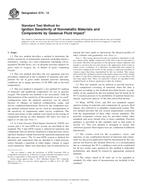
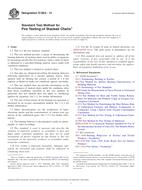 ASTM E1822-13
ASTM E1822-13 ASTM E1995-12
ASTM E1995-12 ASTM E2032-09(2013)..
ASTM E2032-09(2013)..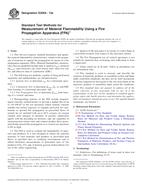 ASTM E2058-13a
ASTM E2058-13a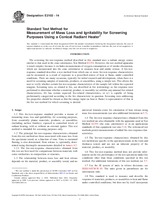 ASTM E2102-14
ASTM E2102-14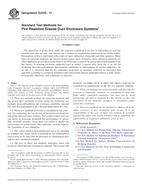 ASTM E2336-14
ASTM E2336-14
 Cookies
Cookies
